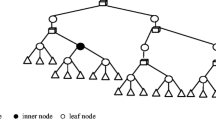Abstract
A major fraction of ray-tracing computation time is spent on ray-object intersection calculation. To reduce this calculation cost, one method, ARTS, subdivides the 3-D object space into voxels and uses a 3-D line-drawing routine to simulate ray propagation in the subdivided space to select objects for intersection testing. Finer space subdivision gives better object selection resolution and fewer ray-object tests. However, as the subdivision increases, the improvement is offset by a linear degradation of the line-drawing-routine efficiency and a cubic growth of the memory requirement. We solve these time and memory scalability problems in ARTS using an adaptive 3-D line-drawing algorithm, which traverses space with multiple stepsizes, and a hybrid database that employs both the octree and the 3-D array data structures. The space traversal cost in our solution grows logarithmically with the subdivision increase, and the memory requirement grows only linearly.
Similar content being viewed by others
References
Arvo J, Kirk D (1987) Fast ray tracing by ray classification. Comput Graph (SIGGRAPH), pp 55–64
Arvo J, Kirk D (1988) A survey of ray tracing acceleration techniques. ACM SIGGRAPH'88 Course Notes
Bresenham JE (1982) Incremental line compaction. Comput J 25(1):116–120
Cook RL, Porter T, Carpenter L (1984) Distributed ray tracing. Comput Graph 1803:137–145
Cook R, Torrance K (1982) A reflectance model for computer graphics. ACM Trans Graph 1 (1):7–24
Cleary J, Wyvill G (1988) Analysis of an algorithm for fast ray tracing using uniform space subdivision. The Visual Computer 4:65–83
Cleary J, Wyvill B, Birtwistle G, Vatti R (1983) Multiprocessor ray tracing. Technical report, University of Calgary
Dippe M, Swensen J (1984) An adaptive subdivision algorithm and parallel architecture for realistic image synthesis. Comput Graph (SIGGRAPH), pp 149–158
Elfes A (1989) A tesselated probabilistic representation for spatial robot perception and navigation. In NASA Conference on Space Telerobotics. JPL/NASA
Fujimoto A, Iwata K (1985) Accelerated ray-tracing. Comput Graph, pp 41–65
Fujimoto A, Perrott CG, Iwata K (1986a) Environment for fast elaboration of contructive solid geometry. Advanced Comput Graph: Proc of Computer Graphics Tokyo '86, pp 20–33
Fujimoto A, Tanaka T, Iwata K (1986b) ARTS: accelerated ray-tracing system. IEEE Comput Graph Appl, pp 16–26
Glassner AS (1984) Space subdivision for fast ray tracing. IEEE Comput Graph Appl, pp 15–22
Goldstein R, Nagel R (1971) 3-D visual simulation. Simulation, p 25
Haines E (1987) A proposal for standard graphics environments. IEEE Comput Graph Appl, p 3–5
Kaplan MR (1985) Space-tracing: a constant time raytracer. ACM SIGGR APH '85 Course Notes.
Kaufman A (1988) Efficient algorithms for scan-converting 3d polygons. Comput Graph 12 (2):213–219
Meagher DJ (1980) Octree encoding: a new technique for the representation, the manipulation, and display of arbitrary 3-D objects by computer. Technical report, Image Processing Laboratories, Rensselaer Polytechnic Institute
Phong B (1975) Illumination for computer generated pictures. CACM 18 (6):311
Snyder JM, Barr AH (1987) Ray tracing complex models containing surface tessellations. Comput Graph, p 119–128
Samet H, Webber RE (1988) Hierarchical data structures and algorithms for computer graphics. IEEE Comput Graph Appl, p 48–68
Thibadeau R (1988) CMU raytracer. Technical report, The Robotics Institute, Carnegie-Mellon University
Whitted T (1980) An improved illumination model for shaded display. CACM, p 343–349
Wyvill G, Kunii T, Shirai Y (1986) Space division for ray tracing in CSG. IEEE Comput Graph Appl, p 28
Author information
Authors and Affiliations
Rights and permissions
About this article
Cite this article
Hsiung, PK., Thibadeau, R. Accelerating ARTS. The Visual Computer 8, 181–190 (1992). https://doi.org/10.1007/BF01902138
Issue Date:
DOI: https://doi.org/10.1007/BF01902138




